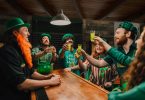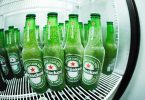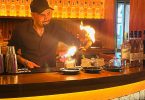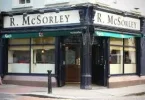Events-driven outlets own the future
Pubs and off-licences looking to increase revenue should be more aware of the value of matching food and drink for their customers according to Mintel in its recently-published Alcohol Retailing – Ireland report.
It points out, “As pubs and off-licences struggle for sales against the supermarkets they need to engage in the current trend for ‘destination value’.
“This is particularly important for operators in the pub trade, which must recognise that they need to be event-driven in order to keep an adequate footfall level within their premises while operating in an economic downturn.”
Mintel’s report states, “Pubs have had to diversify in terms of their offering. A food offering is now an essential as publicans strive to tap into new sources of revenue to increase their customer base, offering coffee in the morning as well as lunch and dinner menu. The emergence of the culture is reflective of this trend. However, introduction of food increases the running costs within the premises and unless carefully managed, increases overheads”.
Declining consumer demand for alcohol combined with the rising costs associated with alcohol and a high number of public houses means that pubs that don’t do food are putting themselves at a major disadvantage, according to the report.
“The gastropub concept offers consumers a revitalised offering from publicans but for it to be a success there needs to be several points of difference to enable premises to differentiate themselves from other pubs and publicans need to have a restaurateur mentality to avoid menu boredom.”
However the restaurant trade offers increasing opportunities as a channel to market for alcohol, states Mintel.
“If restaurants are able to offer consumers value for money while at the same time encouraging more alcohol sales through promotions such as half-price desserts if a customer purchases a bottle of wine, it will provide added incentives for consumers to dine within their premises while also increasing alcohol sales.”
The same opportunities hold true for the pub offering food.
Females are drinking up
Mintel indicates that the gender gap in alcoholic beverage consumption levels is decreasing, thus products that are aimed at females have the potential to achieve sales growth.
“In particular the wine category is underdeveloped appropriately in terms of products that are specifically aimed at women and lower ABV wines, if positioned appropriately, could achieve sales growth.”
This view is backed by NOffLA Chairperson Evelyn Jones who told Drinks Industry Ireland, “Females are indeed drinking more and the challenge for the specialist off-licence is to attract them into our shops. This is proving difficult as it’s easier for a female to subconsciously pop a bottle of wine into her shopping basket while buying the milk and bread than to make a conscious decision to walk into an off-licence. This pattern, in my opinion, reflects the mindset of females as opposed to males who have no qualms about deciding that they deserve or have earned a nice glass of wine.
“Another issue here is the carving up of the household budget. Household wine consumption tends to come out of that budget and its cost is often buried in with the grocery costs. I would hazard a guess that this is also a contributory factor in the choice of purchasing location.
“Choosing wine for dinner parties, family events etc often tends to come from a different budget and so females will shop with a specialist for these events although it would be fair to say these purchases are often undertaken by the male.
“In addition to this, wine clubs, book clubs etc are an ideal opportunity to attract in females as they purchase wine for these events out of their own personal budgets.”
Local link-ins
The increase in cinema attendance offers opportunities for the on-trade which can link into box office hits by offering promotions on cocktails at the launch of a ‘girly chick flick’ or special pre-cinema drink and food offerings for on-trade premises that are located near to cinema premises.
Competitors to on-trade sales
Off-trade
The increase in the value of the off-trade sector is not reflective of the current trading situation for off-licences. Although in-home consumption of alcohol has increased, this has not positively impacted the country’s off-licences.
In the independent off-trade sector, 2,600 jobs have been lost in the last three years alone with average turnover down by between 25 and 50 per cent.
Evelyn Jones points out, “The newspapers are awash with cut-price and volume deals for alcohol on a daily basis as the large retailers use alcohol to compete for their grocery market share.
“In 2010 it was price discounting of standard sizes. In 2011 the trend was towards the price discounting of larger volume deals and larger than standard spirit sizes is a newer and alarming development.
“In addition to this clever insertion of phrases into the RRAI Code such as ‘as far as possible’ negate its proposed intention and allow for constant irresponsible manipulation of the display and sale of alcohol in Ireland. This war between the retail giants for footfall is making the survival of local – often family-owned – specialist off licences untenable.”
Mintel also points out that alcoholic beverages are a large but declining component of personal consumption. Per capita consumption has dropped from 13.5 litres in 2006 to 11.4 litres in 2009 and this figure will continue to decrease as the economic climate remains uncertain, predicts Mintel.
Cross-border
The two per cent VAT increase here coupled with the potential effects of the eurozone crisis on the £/€ exchange rate could lead to a renewal in cross-border shopping, thus further increasing the value and volume of the NI off-trade in 2012.
Online purchasing
The report also takes a look at the progress of online purchasing, noting that in 2011 15 per cent of NI and four per cent of RoI consumers bought alcohol online.
Consumers will pay for quality offerings
On a positive note for the future, consumers are more willing to pay a premium price for good quality beer and wine, with 37 per cent commenting that they would pay extra for good quality beer and 33 per cent commenting that they would pay more for good quality wine.
“This is an area where the specialist sector can really shine,” says Evelyn Jones, “Now more than ever we need to maximise the issues we can control and continue to take pride in what we do. “We need to work harder at being the experts in our field. We can all be specialists in terms of knowledge. All that takes is time and effort and time is something we all have. How we manage our work time is important. Quiet times are an opportunity to acquire knowledge. Genuine knowledge and empathy with the products that we sell, not to mention the best way to sell them, enables us to engage with customers in a more meaningful way. We need to give our customers more for their money than just a bottle .We need to give them quality information, quality service and quality product every single time and to use this as a means to acknowledge and genuinely appreciate that they have chosen to spend their ‘hard-earned’ with us. We need to commit to making their visit to our shops a genuine pleasure. Anything less will not do.”
The report also point out, “Drinks manufacturers should focus their NPD activities on 18 to 24 year-olds who have yet to establish set drinking patterns in terms of the drinks they are prepared to purchase. “NPD targeted at this age group needs to not only find appropriate channels to market, but also needs to ensure that launch activities marry with the consumer group’s wants, needs and aspirations.
“On a more cautionary note, as 18 to 24 year-olds are more willing to try new drinks, this also suggests a lack of brand loyalty. Thus maintaining brand loyalty within this age group may prove more challenging than that of older consumer age groupings.
“Conversely, the 18 to 24 year-olds’ acceptance to try new drinks also offers drinks manufacturers the opportunity to generate brand loyalty within this age category.”
Potential in the no/low alcohol sector
The no/low alcohol sector is growing in importance.
“As the non-alcoholic market continues to increase along with the increased promotion of the damaging effects alcohol can have on an individual’s health, this will place added pressures on the on-trade premises in terms of their alcoholic beverage sales.”
Mintel makes use of a BMRB TGI survey of around 3,0000 adults to break down consumers into a number of different types.
The largest grouping, Social Drinkers, will continue to drink more outside the home as it is part of their lifestyle and social setting.
“There are opportunities for increasing the frequency of drinking outside the home if on-trade premises become more events-driven thus giving these consumers an added incentive to go out with their partner or to meet friends at such events.”
VFI Chief Executive Padraig Cribben comments, “While it is difficult to argue with many of the findings it needs to be said that food may not be the panacea for all. There still are openings for good quality, well-run drinks-only pubs. Food, in some cases, will lead to a faster demise as costs can rocket if the overall volumes are not achieved. The future is really about knowing the customer base, positioning the offering accordingly and then ensuring top-class customer service.
“Events/occasions will play a big part. These will be a combination of parties initiated by the consumer or attractions created by the publican. Central to this will be marketing of the venue and the particular event or offering.”








